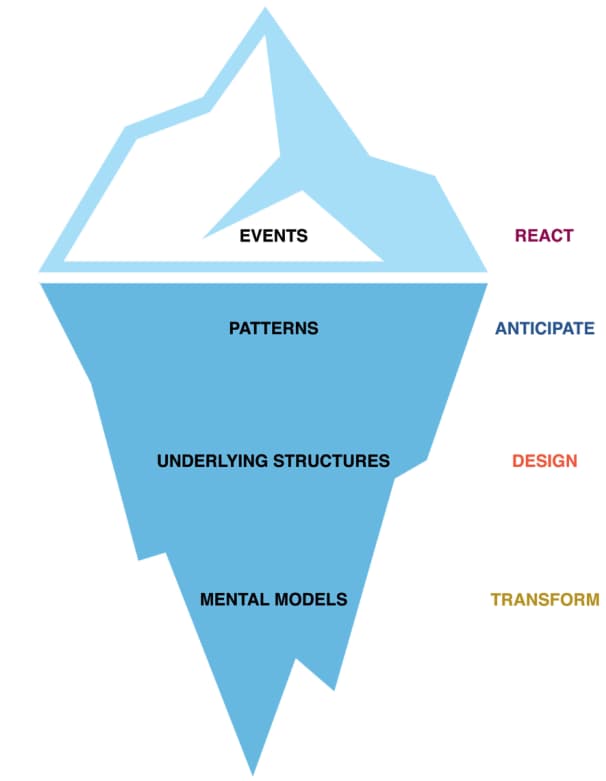How to solve complex problems using systems thinking
So you have what appears to be an unsolvable problem on your hands. It’s an important issue that’s proven to be chronic, its recurrence has made it familiar enough to be identified with a known history, and many have unsuccessfully tried to solve it before.
What you have is a complex problem. Fortunately, a tested strategic approach already exists for solving complex problems - systems thinking.

What is Systems Thinking?
Founded in 1956 by MIT professor Jay Forrester, systems thinking is an approach to solving complex problems by understanding the systems that allow the problems to exist. You have a complex problem when:
- There’s no clear cut agreement on what the problem really is because the context it depends on evolves over time.
- It’s difficult to assess what the real causes are behind the problem due to many factors and feedback loops influencing each other.
- It’s not certain what the best steps are to solve the problem because there are many potential and / or partial solutions that may require incompatible and even conflicting steps.
- It’s hard to pinpoint who has sufficient - ownership, accountability, and authority to solve the problem, or if there even is just a single individual that suits the criteria — and it’s challenging to keep various stakeholders from getting in each others' way.
Where traditional analysis zooms into a smaller piece of a whole, systems thinking zooms out to view not just the whole, but other wholes that are affecting each other. Through this approach, systems thinking formalizes methods, tools, and patterns that allow practitioners to understand and manage complex settings and environments. This is why systems thinking is important — and effective — in solving complex problems.
3 Unique Systems Thinking Benefits
Like other established approaches to solving different kinds of problems, systems thinking can prove insightful and effective when used properly. Beyond those general benefits, systems thinking also presents some unique advantages:
Systems Thinking Allows Meaningful Failure
Failure is a discovery mechanism in properly applied systems thinking. It allows you to learn and improve the design or implementation of your solution. Failure in systems thinking can:
- Allow you to learn and adapt from small missteps quickly.
- Shows you the right option, or at least reduces the wrong ones, when it comes time to test hypotheses.
- Only temporarily hamper a system, not completely jeopardize it, in exchange for meaningful input.
Systems Thinking is Inclusive and Collaborative
Because of the holistic viewpoint taken in systems thinking, it inherently opens up levers for collaboration across involved parties. It isn’t just nice to gain input from diverse stakeholders with dynamically interrelated roles and interests — it's required.
Implemented properly, systems thinking encourages a culture of inclusiveness and collaboration to fix systemic problems that in turn benefit multiple stakeholder teams simultaneously.
Systems Thinking Provides Actionable Foresight
Part of why complex problems are hard to solve is because each involved party only ever sees their portion of the issue. Therefore, they typically execute solutions that resolve parts of the constantly evolving problem, which in the holistic view may even lead to other issues or complications.
Systems thinking allows you to predict how systems change and how steps within parts of the system will impact the whole. In applying systems thinking, you analyze causal structure and system dynamics, assess policies and scenarios, and test action steps and hypotheses to foresee consequences in order to synthesize long-term strategies.
Solving Complex Problems with System Thinking Frameworks and Methodologies
So how do you use systems thinking and its frameworks and methodologies in your organization? Systems thinking is not an instant panacea. Implementing its methods and frameworks isn’t like applying smart charts to raw data on spreadsheets. Those aren’t complex problems.
The implementation of systems thinking involves the application of frameworks that illustrate levels of thinking, and the use of tools to allow people to better understand the behaviors of systems.
The Iceberg Framework
At a primary level, systems thinking takes a holistic view to try and understand the connectedness and interactions of various system components, which themselves could be sub-systems. You can start by focusing on points that people gloss over, and attempt to explore these issues by focusing on aspects you don’t understand. The iceberg framework in systems thinking can guide you through this.

The iceberg framework illustrates four levels of thinking about a problem, arranged thus:
- “Events” - Events form the tip of the iceberg. Events that characterize a complex problem are the most visible, and therefore also the ones that appear to require being addressed in an immediate, reactionary way. This level of thinking is the “shallowest,” as typically events are only symptoms of underlying issues.
- “Patterns and trends” - Directly below the tip of the iceberg, the Patterns level is the first one hidden from view. Thinking deeper about events can lead problem solvers to more insight into patterns and trends that lead to them. Any approaches to solving patterns and trends will more effectively resolve events.
- “Underlying structure” - Even deeper below the surface, you’ll find there are underlying structures that influence the patterns and trends that lead to the visible symptoms of complex problems. This is where the interaction between system components produces the problematic patterns that in turn cause the visible events.
- “Mental models” - Finally, the bottom of the iceberg that props everything up are the assumptions, beliefs, and values held about a system culminating in the inadvertent creation and maintenance of underlying structures that result in unfavorable patterns within systems, which in turn bubble up to the surface as symptomatic events.
Once systems thinking practitioners understand this framework, they can employ tools and technology that allow human perception to genuinely digest the behavior of complex systems. At this level of systems thinking, qualitative tools generate knowledge to unravel complex problems.
Causal Loop Diagrams and System Archetypes
Some of the most common and flexible tools in systems thinking are causal loop diagrams that demonstrate system feedback structures. They show causal links between system components with directional cause and effect. Causal loop diagrams display the interconnectedness of system components to serve as a starting point for further discussion and policy formulation. Naturally, these diagrams can also help problem solvers identify in which parts of the system they can assert a positive influence to impact the entire loop favorably. In effect, these diagrams can help prevent poor decisions such as quick fixes.

Another important tool in systems thinking are the system archetypes that generally describe how complex systems work. They are generic models or templates representing broad situations to provide a high-level map of complex system behavior. Because they have been well-studied and mapped, these models can identify valuable areas where steps can be taken to resolve complex problems through interventions that are called leverages.
In general, there are two basic feedback loops (reinforcing and balancing) that identify nine system archetypes (or eight or ten, depending on who you ask):
- Balancing loops with delays
- Drifting goals
- Escalation
- Fixes that fail
- Growth and underinvestment
- Limits to success
- Shifting the burden
- Success to the successful
- Tragedy of the commons
Each of these archetypes are rarely sufficient models on their own — they merely offer insight into possible, common underlying problems. They can of course also be used as a basic structure upon which you can develop a more detailed model specific to your complex systems.
Adding Advanced Tools into Your Systems Thinking Toolbox
There are several dynamic and structural thinking tools in the systems thinking repertoire. Causal loop diagrams and system archetypes are dynamic thinking tools. Graphical function diagrams and policy structure diagrams are structural thinking tools. All of these can be mapped or used in computer-based tools like a management flight simulator or learning lab.
Of course, there are tools to what you can achieve with your toolbox.
Causal loop diagrams, for example, are static — they cannot describe the evolving properties of a system over time. To overcome such limitations, you need to simulate management issues quantitatively through system dynamics modeling.
Computer models of system dynamics allow you to explore time-dependent complex system behavior under different states. They essentially enable you to simulate how a causal loop diagram evolves as it is affected by different assumptions over time.
Solving Complex Problems in Project Management

So should you start learning about causal loop diagrams and begin shopping for the best systems dynamics computer modeling tools in the market as soon as you find a project management problem you can’t seem to solve? Don’t jump the gun.
You can implement systems thinking in inquiry and problem diagnosis to great effect without needing diagrams and computer models. Apply the concept of the iceberg model and you might already find you’re asking better questions than before, or you’re catching common quick fix solutions — like needing more budget or hiring more people — that don’t address deeper problems.
Once you realize that you’ve got a complex problem that requires an in-depth systems thinking approach, you can then explore your options with your team. The important part is to embrace the mental models that make systems thinking invaluable for understanding complex systems and resolving the complex problems that arise from them.








